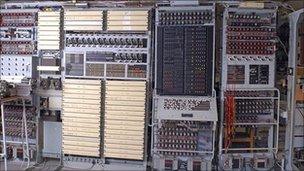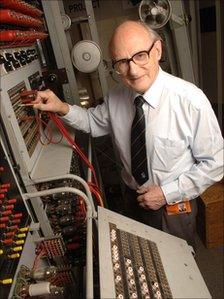Rebuilding the codebreaking computer Colossus at Bletchley Park
- Published

The rebuilt Colossus will be surrounded by a new gallery telling the story of its development
It was the world's first programmable computer, invented by the codebreakers at Bletchley Park in World War II to speed up the code decryption process.
But after the war, eight of the 10 Colossus machines, which had been used to decipher messages between Hitler and his generals, were dismantled to avoid their secrets falling into the wrong hands.
The remaining two computers were taken to the safety of a building in London which would be the forerunner of GCHQ.
Now, decades on, a rebuilt Colossus is on display to the public at the National Museum of Computing (TNMOC) back home at Bletchley Park, and a new gallery is being built around the machine which will bring its story alive for future generations.
Work on rebuilding the machine was started in the 1990s by Tony Sale who died in August.
The new chief engineer of the Colossus rebuild, Phil Hayes, said he hoped the new displays would encourage other people to become interested in computer science.
"Colossus plays a huge part in the history of electronics and computing and we aim to create a gallery to inspire future generations of computer scientists and engineers," he said.
The original Colossus was designed by a team led by Tommy Flowers and was first used in 1944.
Experts generally acknowledge that this intelligence shortened the war by two years.
The first details about the highly-secret machines were only publicly released in 1975.
'Kept odd scraps'
Mr Sale and his team began to rebuild the Bletchley Park Colossus using fragments of available information.
TNMOC trustee, Kevin Murrell, said that this was an achievement in itself, because records were not meant to be kept.

Tony Sale led the team which rebuilt Colossus
"People were instructed not to keep any records, but engineers, being what they are, did keep odd scraps of circuit diagrams and there were a few pictures," he said.
"Tony Sale actually went and spoke to as many people as he could, many engineers and designers, and got them to recall how they had designed the machine and what they could remember [about it]."
The completed and fully operational rebuild is now in Block H of the museum, on the spot where Colossus No 9 stood during the war.
The workshop space where it stands will be turned into a gallery which will allow visitors to walk all around the machine and look at "exciting interactive displays" telling the Colossus story.
Museum bosses said they hoped the new exhibition would also be a tribute to the man who recreated the computer.
"As well as explaining how the machine worked, we're also going to explain how the rebuild process took place and all the work that Tony did to do that," said Mr Murrell.
"Tony is captured on lots of film and recordings so we can use that information to tell that story."
'Awe-inspiring'
TNMOC houses the largest collection of functional historic computers in Europe.
Members of the public are being invited to contribute to the new gallery's £150,000 cost by sponsoring valves on a virtual model of the machine.
Tim Reynolds, the acting chairman of the museum, which is an independent charity with no lottery funding, said that it welcomed all contributions to help them "do justice to Colossus and enthral visitors for years to come".
"Tony Sale's tribute to the wartime codebreakers is awe-inspiring and we are seeking resources to present the rebuilt Colossus so that generations to come will be able to understand its significance," he said.
- Published22 December 2011
- Published9 March 2012
- Published13 September 2010